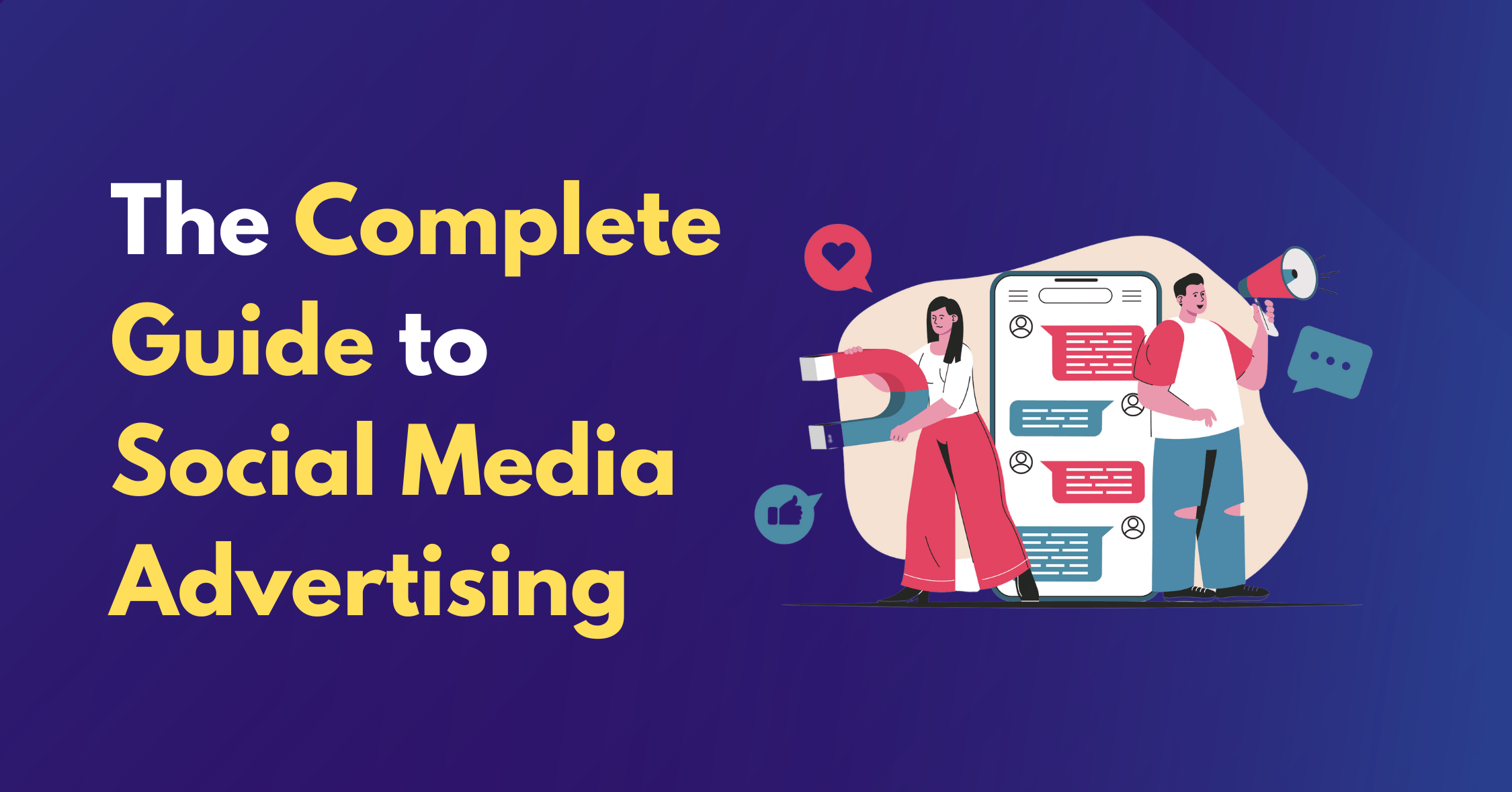The Complete Guide to Social Media Advertising
Social media advertising is a great way to reach your target market and increase brand awareness. If you do it right, it can be an incredibly cost-effective marketing channel. Social media advertising can, however, be a time and money waste if done improperly or without a strategy in place.
To ensure success in social media advertising, it is crucial to understand your target audience and tailor your content accordingly. Additionally, regularly monitoring and analyzing the performance of your campaigns can help you make necessary adjustments and optimize your results.
In this post, we’re going to cover all the various ad campaigns you could set up on social media, the pitfalls to avoid, and some of the latest strategies you should test for your next project.
What is Social Media Advertising?
Social media advertising is a digital marketing strategy that involves the creation and placement of ads on various social media platforms to connect with a specific target audience. These ads can take the form of images, videos, stories, and more, and they are designed to promote products, services, content, or messages effectively.
Social media advertising provides the opportunity to select the appropriate platform for the intended audience, tailor ad formats to specific campaign goals, and fine-tune audience targeting by demographics, interests, and behaviors.
Advertisers set budgets, define ad placement, schedule ad display times, and craft compelling ad creatives with clear calls to action. With analytics and data-driven insights, advertisers can monitor and optimize their campaigns for better performance, while remarketing efforts help re-engage users who have shown previous interest in the brand.
Social media advertising is a vital tool for building brand awareness, driving traffic, generating leads, boosting sales, and fostering meaningful engagement with a highly targeted audience.
Types of Social Media Advertising
Certainly, here are some of the most popular social media advertising platforms in detail:
Facebook Ads:
Facebook is one of the largest social media platforms for advertising, offering a range of ad formats including image ads, video ads, carousel ads, and more.
Advertisers can target specific demographics, interests, behaviors, and locations, making it highly versatile for various business types.
Facebook owns Instagram, so social media ads can also be placed on Instagram through the same platform.
Also Read: Facebook Advertising: Reaching Your Target Audience
Instagram Ads:
Instagram, known for its visual content, provides advertising options that include photo ads, video ads, carousel ads, story ads, and more.
It works particularly well for companies that offer goods or services that are appealing to the eye.
Instagram advertising is integrated with Facebook’s ad platform.
Twitter Ads:
Twitter ads can promote tweets, profiles, and trends.
Promoted tweets, accounts, and trends are a few examples of advertisement formats.
Twitter is a suitable platform for real-time marketing and engaging with trending topics.
LinkedIn Ads:
LinkedIn is the primary platform for B2B marketing, offering advertising options like sponsored content, sponsored InMail, display ads, and dynamic ads.
Advertisers can target professionals by job title, industry, company size, and more.
Pinterest Ads:
Pinterest offers promoted pins, which are pins that appear in users’ feeds, search results, and category feeds.
It is an excellent platform for businesses related to fashion, home decor, recipes, and DIY.
Snapchat Ads:
Snapchat’s advertising includes Snap Ads, Story Ads, and augmented reality (AR) lenses and filters.
It’s popular among younger audiences and well-suited for creating engaging content.
TikTok Ads:
TikTok’s advertising options include In-Feed Ads, Branded Hashtag Challenges, and Branded Effects.
TikTok is known for its short, creative videos, making it great for reaching younger demographics.
YouTube Ads:
YouTube offers various ad formats, such as TrueView ads, Bumper Ads, and Discovery Ads.
It’s the go-to platform for video marketing and reaches a vast audience.
Social Media Ad Tips and Strategies
Now that you know the types of ads you have available, let’s talk about the best social Advertising strategies to employ to maximize your ROI.
Also Read: Unlocking Success with Social Media Advertising Strategies
Perfect Audience Targeting
Targeting your audience is one of the key components of any successful social media campaign. When you target the right audience, your social media marketing efforts will be more successful. Determine who would most likely want to buy what you’re selling and focus on reaching those people with your ads.
Social media advertising platforms have hyper-targeting and personalizable options that enable you to split your audience into segments and build campaigns for each of these segments.
You may reach individuals who have interacted with your content, generate lookalike audiences with similar attributes, target based on demographics, interests, keywords, hashtags, or conversations, upload your audience list, or create custom audiences.
Pro Tip: Get all the demographic data on your social media platforms with Google Analytics. Additionally, to gain ideas for what to test next, undertake market research to identify which target markets your rivals are targeting.
Grab the user’s Attention in less than 3 seconds
People’s attention spans are getting shorter by the year in the age we live in. Due to the overwhelming amount of information available, attention on social media is becoming harder to obtain and maintain (the average human attention span is 8.25 seconds, which is lower than that of a goldfish).
For instance, Facebook users take on average between 0.25 and 1.7 seconds to recall material from a brand. So marketers need to think outside the box to capture user attention. So how can content be produced that captures and holds the attention of viewers?
Make sure your advertisement does so quickly and effectively as you only have three seconds to catch the user’s attention!
For example, if your product is a video game, show images from that game in an engaging way. If it’s apparel, showcase models wearing it or show them in motion engaging in entertaining or interesting activities. Even better, utilize gifs or memes related to what you are offering.
Your writing must be sincere, relevant, and relatable. Here are some pointers to consider:
- Make it simple. Consistently use the same fonts, graphics, and designs.
- Tell a story. To demonstrate your product from various perspectives, use video or carousel ads. Use only a few filters. Being able to relate to your audience is made simple by this.
- Follow the trends of the day. Increase engagement by using current music, words, and memes.
- Conduct a competitive analysis before launching your campaign. This will give you insight into the kind of strategies your competitors are using to convert a similar audience.
Improve the Quality Score
Quality score is how each platform measures the social media advertising effectiveness of your ad and determines the cost per click (CPC) of your Advertising campaigns. It has a scale of 1 to 10 and is based on the effectiveness of your advertisement, as well as engagement and conversion rates.
Build Ads for Mobile
Nearly 93% of the world’s Internet population are mobile users. Unless your ads are specifically for desktop users, ensure they display correctly on all devices. This includes your landing pages as well.
A high conversion rate, precise location messaging, and tailored advertisements are just a few advantages of mobile-focused ads. Here are some pointers for effective mobile optimization:
- Turn static images into a video with slideshow ads
- Shorten your video ads. Shorter videos tend to have more engagement on mobile.
- Crop your visuals to fit the mobile screen.
- Plan for optimal aspect ratio. Before creating your ad, make sure to review the visual requirements for each platform. Instagram and TikTok, for example, use a vertical screen video format, compared to the horizontal format on YouTube.
- Create video ads that are engaging with or without sounds. Also, include subtitles to communicate your message
Let your organic posts inform your ads
Get a feel of the kind of content that resonates with your audience before you start running a lot of social media advertisements. This will provide you with some understanding of the kinds of advertisements you ought to run and how they ought to appear. Examine your most popular natural postings, and consider using some of them in a social media marketing effort.
Test your ads
Ad testing is crucial as it generates data to facilitate future campaigns. So instead of guessing, you have hands-on experience in the strategies that can create better results from your campaigns.
One way to do this is through A/B testing. This implies contrasting two ads to identify the best performer. The effectiveness of CTAs, ad designs, wording, etc., can all be tested. In the end, this lessens the likelihood of producing vanity metrics and ensures high-quality leads.
Also Read: The Future of Advertising: Harnessing Potential of Social Media Platforms
Social Media Advertising Cost
The social media advertising cost can vary depending on the platform and the audience, but there are ways to gauge how much you should expect to pay.
CPM (cost per thousand impressions):
CPM is the average price you’ll pay per 1,000 ad impressions—the number of times your ad appears on a page or app. This metric doesn’t take into account whether anyone interacted with your ad, just that it was shown. Because they can charge more for their inventory, more well-known or frequently visited websites will have higher advertising rates.
CPC (cost per click):
You only pay when someone clicks on your ad and visits your site or app. These types of ads tend to have higher conversion rates than other forms of social media advertising since they’re so targeted at people who already have an intent in mind—they want what you’re selling!
CPA (cost per action):
CPA (Cost per Action) type of advertising charges users based on the actions they take after viewing an ad, as opposed to paying for clicks as CPC advertising does. For instance, if a user fills out an online form or purchases something within a set period of time after reading a post about it, payment processing fees are included in that calculation of total costs rather than being calculated separately as a part of a different service entirely.
conclusion
You must have a firm understanding of your company’s aims and objectives before you begin. If done properly, paid social media initiatives may result in a significant return on investment for your company. Do you require assistance beginning your social media campaigns? Look no further!
Here at Metaloop Marketing, we have industry-vetted social media advertising experts.
Our specialists can help you develop a thorough social strategy, manage your digital advertising campaigns, and scale because they have demonstrated experience running advertisements for businesses that are similar to your niche.



Write a Comment